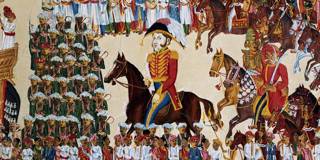Although British imperialists often told themselves that by taking over the public administration of China and the Indian subcontinent, they would bring those civilizations into the modern age, the reality was altogether different. Two histories of Pax Britannica make clear that economic exploitation was always the top priority.
PRINCETON – Centuries are usually analyzed with reference to the great powers that dominated them. The nineteenth century was the era of Pax Britannica, although most people now realize that the “pax” in that case was not particularly peaceful. The twentieth century became the American Century, as heralded in Henry Luce’s February 1941 editorial in Life magazine. And the current century, one often hears, will belong to China (and, perhaps, to India).
How did this kind of thinking start, given that no one would characterize the fourteenth or fifteenth centuries this way? The rise of military superpowers provides part of the answer, but economic and financial domination explains much more.
Nowadays, a key feature of the national narratives in China and India is an effort to explain why they did not reach their current levels of regional or global influence much earlier. After all, both have long had spectacular accumulations of wealth and large populations. The problem is that both relied on institutionally flawed and militarily vulnerable imperial systems. Their national stories are thus about imperial hubris, but also about how commercial and economic calculations tore the old empires apart. That is why the Chinese still lament what they call the “century of humiliation.”

Hans van de Ven, Breaking with the Past: The Maritime Customs Service and the Global Origins of Modernity in China, Columbia University Press, 2014.
PRINCETON – Centuries are usually analyzed with reference to the great powers that dominated them. The nineteenth century was the era of Pax Britannica, although most people now realize that the “pax” in that case was not particularly peaceful. The twentieth century became the American Century, as heralded in Henry Luce’s February 1941 editorial in Life magazine. And the current century, one often hears, will belong to China (and, perhaps, to India).
How did this kind of thinking start, given that no one would characterize the fourteenth or fifteenth centuries this way? The rise of military superpowers provides part of the answer, but economic and financial domination explains much more.
Nowadays, a key feature of the national narratives in China and India is an effort to explain why they did not reach their current levels of regional or global influence much earlier. After all, both have long had spectacular accumulations of wealth and large populations. The problem is that both relied on institutionally flawed and militarily vulnerable imperial systems. Their national stories are thus about imperial hubris, but also about how commercial and economic calculations tore the old empires apart. That is why the Chinese still lament what they call the “century of humiliation.”